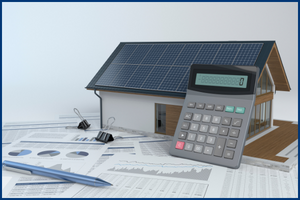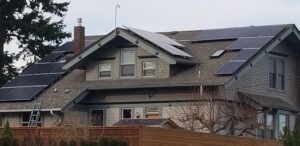How Much Does a Grid Tie Solar System Cost?
How Much Does a Grid Tie Solar System Cost?
One of the first questions people ask about solar is ‘how much does it cost’? Unfortunately, there isn’t a universal answer because the cost of a solar system can vary quite a bit from household to household. Contrary to popular belief, the size of your solar system is not determined by the square footage or number of people in your home, but instead on how much power you use throughout the year.
Without using your actual 12-month average historical power usage and knowing how much space you have for an array, it is impossible to determine what size your system should be and how much it would cost. However, our recent client data shows most of our clients’ systems are sized between 8kW and 16kW and cover between 50% and 70% of their total power usage. Based on these sizes, a rough budget for a full service roof mounted solar system is between $24,000 to $42,000, and it will typically pay for itself in 12-17 years. Though that may seem like a long time, remember that solar is a guaranteed investment that begins paying you back the moment your system is turned on. And, most solar panels and micro inverters are guaranteed for at least 25 years. That means they will be saving you on monthly expenses for many years after you’ve recouped your investment.
 If you have a new home, (new construction or new to you) it is a bit more complicated to determine the proper size of a system because there isn’t any historical electrical consumption to use as a baseline. So instead we either do an analysis of your anticipated loads, or we just use the amount of roof space you have and your budget goals to select a system size.
If you have a new home, (new construction or new to you) it is a bit more complicated to determine the proper size of a system because there isn’t any historical electrical consumption to use as a baseline. So instead we either do an analysis of your anticipated loads, or we just use the amount of roof space you have and your budget goals to select a system size.
There are many additional factors that impact your solar power system’s size and cost, including:
- Installation Type: DIY, Full Service
- Mounting: Rooftop, Ground/Pole
- Roof Pitch
- Roof Layout
- Power Use Coverage: Partial, Full
- Incentives
- Where You Live
Installation Type
Whether you choose to install your system yourself or prefer a full-service installation will change the overall cost of your solar power system. If you are comfortable with construction and electrical work and you have the time, doing your project yourself may be the right option for you. Depending on how much support you are looking for, you could complete most of your project yourself and hire an electrician to inspect the final system. When considering whether to go DIY or full service, remember that the difference between the two is much more than just the installation labor. A full-service solar installation can cost a bit more, but they also provide a significant number of services beside just labor. A reputable solar contractor will have the expertise and experience to make going solar simple and stress-free.
Mounting
Where you put your solar panels can have a significant impact how much your power system costs. Generally speaking, roof mount racking will cost less than a ground or pole mounted system. Roof racking simply attaches to the roof of a home or building, whereas ground and pole mounts require some sort of foundation. Ground and pole mounted installations also may require additional machines to dig holes for the poles and to trench for conduit runs, as well as to pour a cement foundation to properly secure the poles into the ground.
Roof Pitch
If you are planning to have your solar array mounted onto your roof, a pitch above 6/12 is too steep to walk on and requires a lift or scaffolding to help you or your solar installer safely attach panels without the risk of falling. If the roof pitch is above 6/12 installation is still possible, but it requires some additional planning and costs.
Roof Layout

If you have a home with a multi-faceted roof on the southern-most side, you may need to do multiple sub-arrays to provide the amount of power you want. Sub-arrays may not be significantly more expensive, but they will add something to the labor and material costs for your system. Also, if you have chimneys, roof vents or skylights in the way, they may limit the size of system you can have, or require sub-arrays.
Power Use Coverage
It may be ideal to have a solar power system cover all of your power use, but many people do not have sufficient roof space for an array to do so. Also, it may be cost prohibitive for people who use a lot of power. For these reasons, it is common to have a system account for only a part of your overall power usage. Some people also choose to start with a small solar power system and add to their system later if their power needs change, or as they are able to afford to expand their system system. How much power use you want to cover with solar is the single most contributing factor to the cost of your system.
Incentives
There are some incentives available that will actually reduce your system’s cost. The most significant incentive for solar installations is the Federal Solar Investment Tax Credit, which lets you claim a 30% credit for the total project cost of your solar power system off your taxes if installed between now and 2032.
Another incentive, net metering, allows grid-tied solar systems to earn “credits” with your utility whenever your system produces excess electricity (more than you are consuming at the moment). Then, when you need more electricity than you produce, you spend those credits. In most states net metering credits are at the same rate you pay when you purchase power from your utility. However, it is important to check the net metering policies in your state and for your specific utility to be certain their policies are solar friendly.
Where You Live
The amount of usable sunlight at your home’s location will impact how much power your solar array generates. If you live in an area with fewer average sun hours per day, or if your home’s roof experiences shading at certain tomes of the day or year, you may need a larger system to cover the amount of your electrical use you want.
Interested in getting an accurate estimate of the size and cost of a grid solar system that’s right for you?

